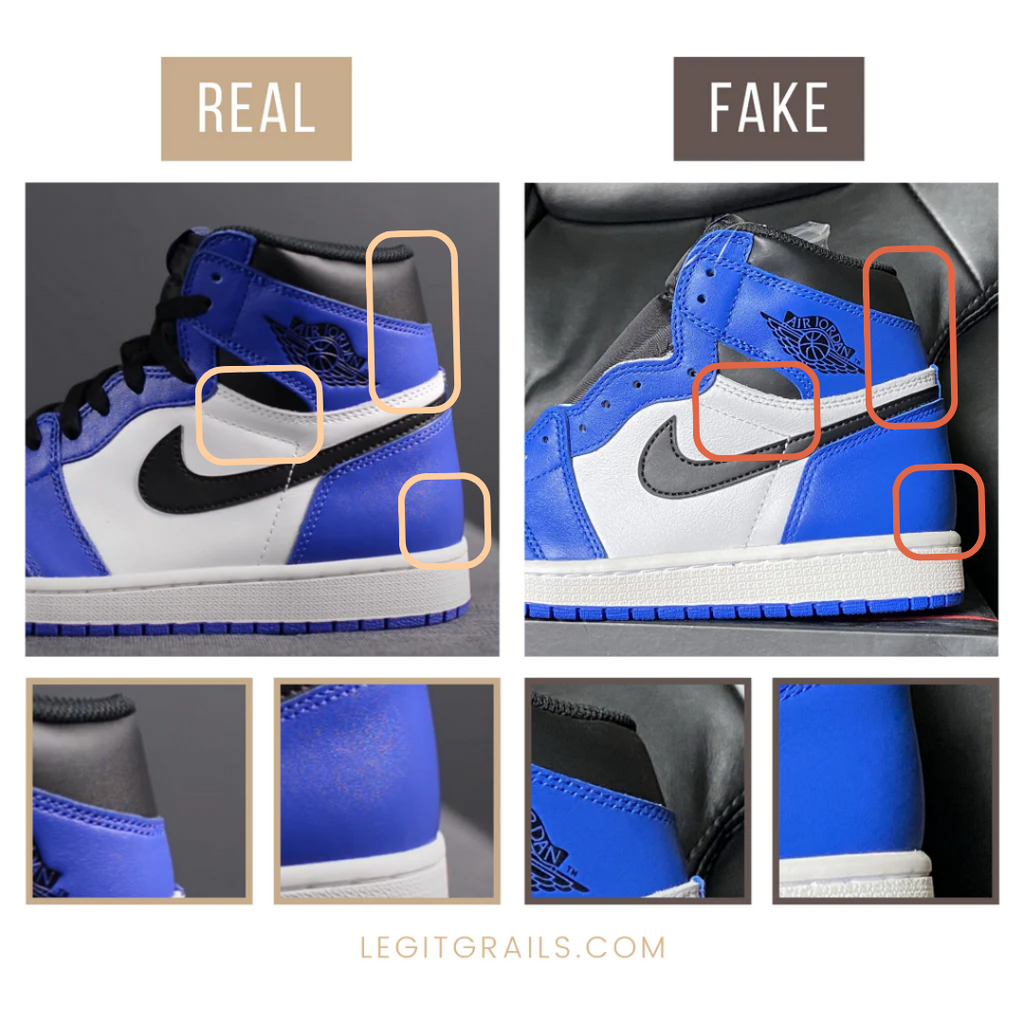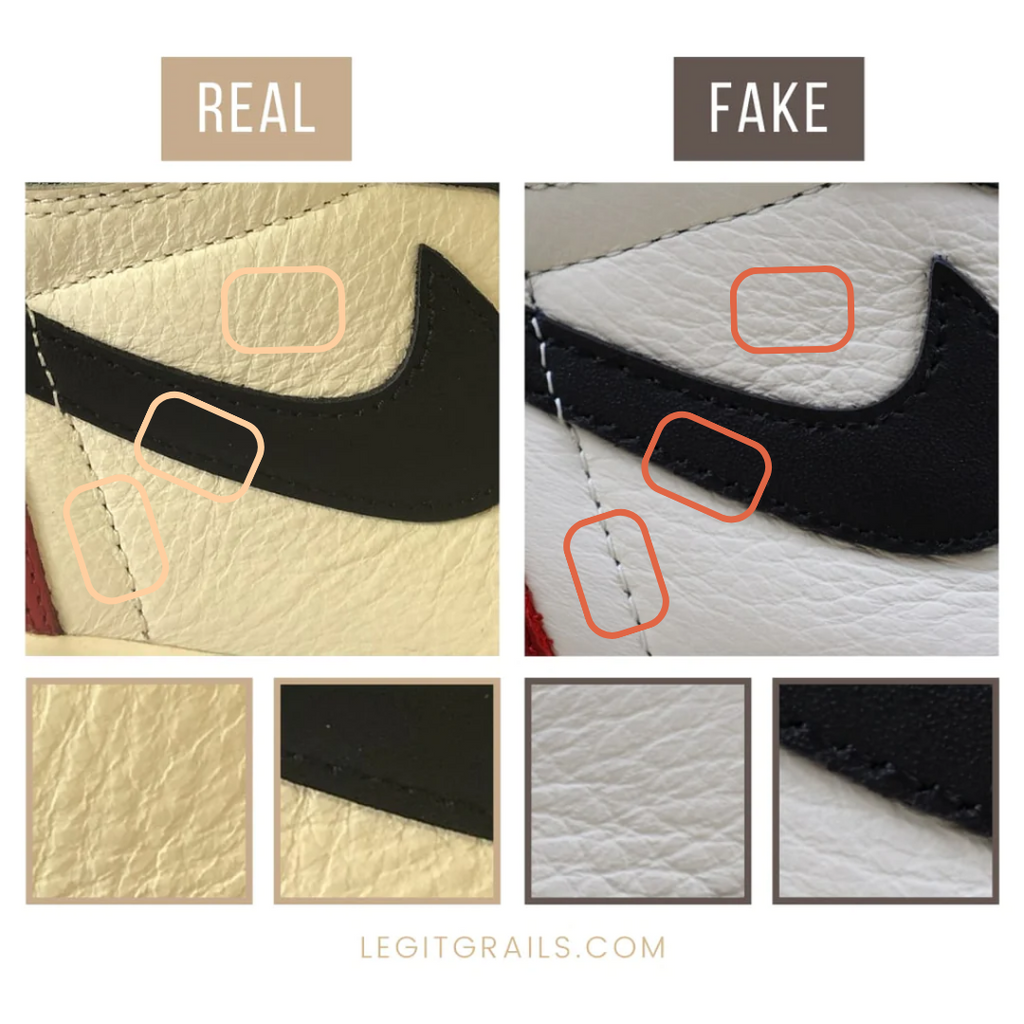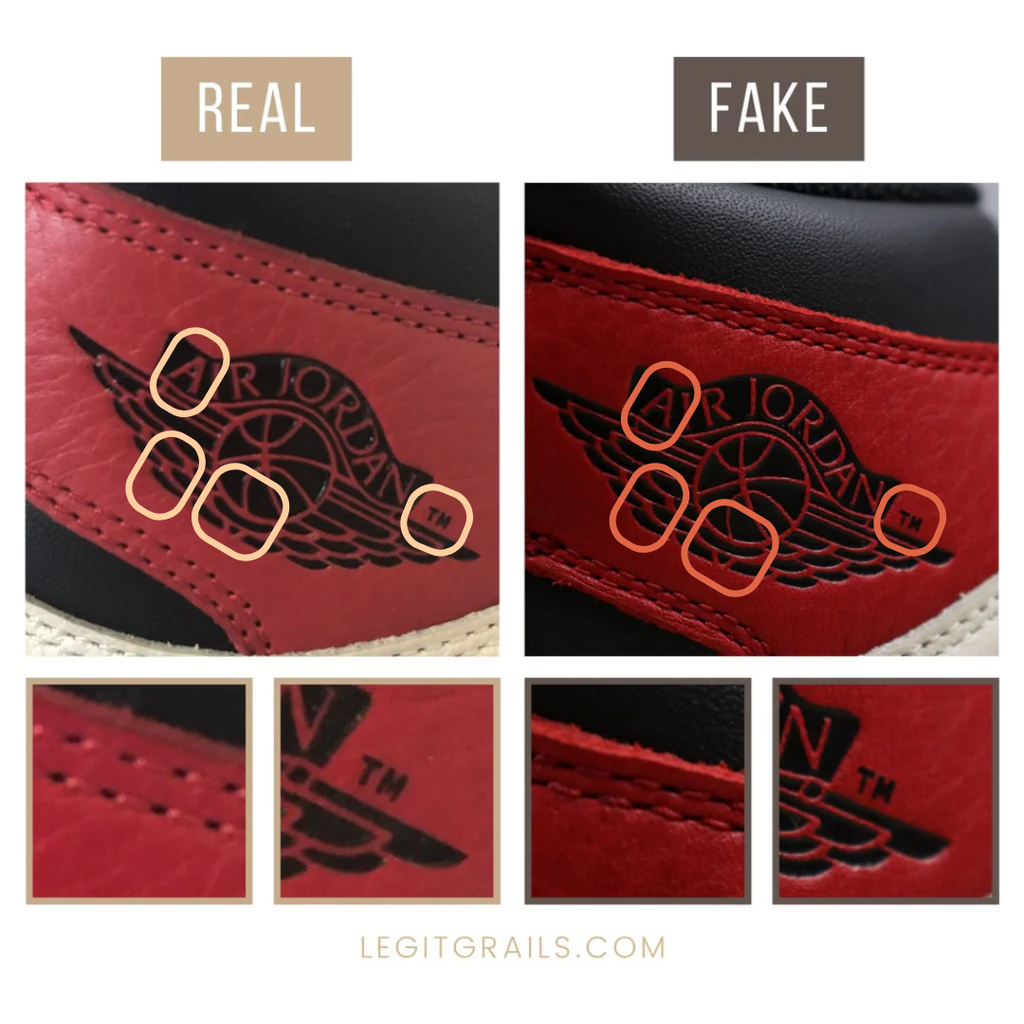How To Spot Fake Jordan 1

Who doesn’t want a spotless pair of Jordan 1s in their collection, right? This pair of shoes is probably a universal mark of sleek and stylish outfits, and the counterfeit factories know that!
Today’s article’ll cover the eight best methods of spotting a fake pair of Jordan 1s! So buckle up, 'cause we’re in for a long ride!
Table of Contents
[ open ]Assessing the Overall Form of the Jordan 1

The shape of Jordan 1 is crucial for telling if they're real or not. Let's dive into it and discover the common mistakes fake makers often make!
- The heel and toe box are your main helpers. For now, let's focus on the heel. The top part should be kind of straight. Fake ones tend to curve too much at the top. The bottom part is the one that should have a slight curve. But replicas often puff it up too much.
- But sometimes, the fake ones go the other way, and the heel is too flat without any curve. Keep an eye out for that too.
- Another mistake is when the middle part of the sole is the wrong size, either too thick or too thin. In this case, the sole might seem okay in thickness, but it's lifted off the ground, while the real one stays flat. Only the front part (under the toe box) should be a little raised.
Authenticating the Swoosh Detail

Often, in fake Jordan 1s, it's either too high or too low. As you can see below, the latter shows that the shoe is not authentic. It could also be positioned too far or too close to the shoelace holes.
Next, we'll check the shape of the Swoosh. The Swoosh shouldn't be too short or too long. Its shape should be clear: a thin stem, a smooth curve, and a sharp, pointed tip.
Stitching is another important factor. In many fake pairs, it's uneven. Make sure all stitches are the same size and length, the thread isn't too thick or thin, and the color matches. Particularly, inspect the stitching that outlines the Swoosh. Also, ensure that the corner stitching and the Swoosh don't cross at the bend or corner.
You Might Also Like: How to Spot Fake Jordan 3 Sneakers
Evaluating the Texture of the Upper Material

Let's dive into a somewhat tricky aspect now—the texture of the sneaker, specifically its leather upper. This can be a bit complex due to potential differences in color, release year, and other factors.
Make sure that the texture of the leather matches the model consistently. You can find plenty in our free guide library if you're looking for guides to verify specific Jordan 1 models.
Here are some of them: Jordan 1 Chicago, Jordan 1 Trophy Room.
In general, Jordan 1s, especially the classic ones, typically have a white crinkled leather upper. The texture should stand out but not be overly crinkled to avoid a messy appearance. Another detail you must look at is the direction of the wrinkles. Genuine pairs have wrinkles that go up and to the right, while fakes have wrinkles that go down to the left.
Additionally, it's important to check the stitching. Authentic stitching is thin and delicate, while fake stitching tends to be thicker and longer.
Examining the Wings Logo for Authenticity

The Air Jordan wings logo is key to verifying Jordan 1 authenticity. Although its appearance differs slightly based on the model, colorway, and release year, you can still spot common mistakes.
- Start by examining the logo's fonts. In the real logo, the "Air Jordan" text has slightly thicker and larger letters, while the fake version has thinner and smaller letters. Additionally, the "™" symbol is incorrect, looking less clear.
- Another significant flaw in fake Jordan 1s is the spacing between details, like the wings. The real logo has wider spacing, creating a broader appearance.
- Look for the double-stitch seam around the logo. Confirm that the gap between the seams matches the original. The fake item often has a larger gap. Also, note that the stitches are a bit smaller than they should be.
Inspecting the Nike Tongue Tag

What you should look for on the tongue tag are the embroidery pattern and the fonts used in both the outer and inner tongue labels.
When it comes to embroidery, it should strike a balance—not too dense or too thin. There shouldn't be any threads sticking out or loose, and no areas without stitching. Also, note that this logo's threads run vertically, not horizontally.
Keep an eye on the font of the Nike logo. Particularly, the "AIR" letters might appear inaccurate, which is a common problem in many replicas. While the word "Nike" generally looks right, fake versions often get "Air" wrong. The letters might not be aligned correctly and can look too bulky.
Additionally, check out the shape of the Swoosh. You'll likely notice that the fake tag has a much slimmer Swoosh with a less defined curve.
Comparing the Toe Box Shape

As discussed earlier, it should gently curve outward, lifting the shoe when it lies flat. The shape should be sleek and rounded, avoiding a boxy look.
To proceed, carefully examine the toe box's shape. As you can see in our comparison, the genuine version is more elongated, and the thin black part around the toe box is narrower. On the other hand, in replica Jordan 1s, the toe box is often shorter and wider. The black area is also thicker.
You should also pay attention to the perforations. Counterfeit perforations are frequently of lower quality and incorrect size. Lower quality means imperfections like non-perfectly round perforations or ones that are larger than the rest.
Don't forget to analyze the arrangement of the perforations since they consistently follow a specific pattern.
Read Next: How To Spot Fake Jordan 3 Fragment
Analyzing the Heel Design

The charm of the Jordan 1's shape lies in its "hourglass" design: wider at the top and bottom and narrower in the middle.
Despite its apparent simplicity, many replica makers struggle with this aspect. Fake Jordan 1 pair often showcase an overly bulky and inflated heel. They miss capturing the distinct hourglass shape and its curvy appeal.
Pay special attention to the small rectangular tab in the center. Aside from the stitching, the central tab on the genuine pair is almost correct. The double stitches should be uniform, each directly above the other. Replicas don't adhere to this pattern, showing uneven placement and stitches of different sizes.
Lastly, examine the texture of the midsole. It should possess an appropriate texture and adhere to a specific pattern. As you can see, the replica Jordan 1 exhibits larger "grains" compared to the authentic version.
Verifying the Outsole Details

The outsole features a Nike logo at its center, surrounded by small stars (asterisks) along the sole's edge.
Starting with the Nike logo, carefully examine it for any variations in the font. The font itself should be accurate, and its placement is crucial. The Nike logo should be right in the middle of the outsole tab. Also, make sure the ® symbol is clear and visible, despite its small size. Don't forget to check the Swoosh, too; in the fake example, the swoosh lacks the required pointed shape.
Lastly, evaluate the shapes of the asterisks. It might be tricky to spot, but try your best to ensure all stars are the same size and shape, with even spacing between them.
Get a Free Opinion on Your Item
From fashion updates to tips & free authentications - let's connect in the LegitGrails Hub!
Join Our CommunityDo Jordan 1’s Run Big?
Jordan 1s normally run true to size. However, it is advised to go down half a size in order to avoid creases on the toe box area. But, of course, it all comes down to your personal preference.
Which Air Jordan is The Most Popular?
Undoubtedly, Jordan 1 stays the most popular model, coming in a great variety of colorways. However, the Air Jordan 1 Retro Chicago stays the most iconic of them all, consistently popular throughout decades.
Where Can I Authenticate Jordan 1?
If you are looking for a reliable and professional legit check service, you’re in the right place! Chat with our helpful team and receive a quick and detailed Jordan 1 authentication.
Take a look here: Jordan legit check.
Conclusion: Safeguard Your Investment in Authentic Jordan 1s
To help you avoid the pitfalls of counterfeit sneakers, here are key features to watch out for that can indicate a fake pair:
- Incorrect Swoosh Positioning: Fake Jordan 1s often have the Swoosh positioned too high or too low, or the shape may be altered.
- Low-Quality Stitching: Authentic pairs feature consistent, neat stitching. Be wary of loose threads or uneven stitching patterns.
- Inaccurate Neck Tag Details: Check for the correct font and placement on the neck tag. Fakes often use incorrect colors or fonts.
- Subpar Material Quality: Genuine Jordan 1s are made from high-quality materials. If the texture feels off or looks cheap, it’s likely a fake.
- Distorted Wings Logo: The wings logo should be clear and properly proportioned. Counterfeit logos may have inconsistencies in font thickness and spacing.
- Poor Print Quality: Authentic prints are sharp and clear. Watch for blurriness, peeling, or overly thick printing on fakes.
By being aware of these indicators, you can make informed decisions and ensure that your collection remains authentic. If you’re ever in doubt, consider seeking professional authentication services to verify your sneakers. Remember, a well-informed buyer is your best defense against counterfeit products. Enjoy your journey in sneaker culture, and may your collection always reflect authenticity and style!








